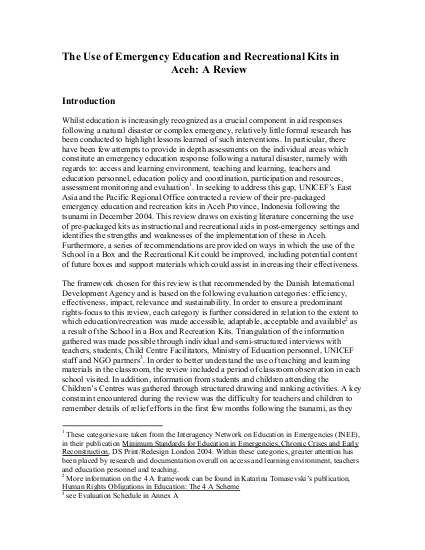
Whilst education is increasingly recognized as a crucial component in aid responses following a natural disaster or complex emergency, relatively little formal research has been conducted to highlight lessons learned of such interventions. In particular, there have been few attempts to provide in depth assessments on the individual areas which constitute an emergency education response following a natural disaster, namely with regards to: access and learning environment, teaching and learning, teachers and education personnel, education policy and coordination, participation and resources, assessment monitoring and evaluation1. In seeking to address this gap, UNICEF’s East Asia and the Pacific Regional Office contracted a review of their pre-packaged emergency education and recreation kits in Aceh Province, Indonesia following the tsunami in December 2004. This review draws on existing literature concerning the use of pre-packaged kits as instructional and recreational aids in post-emergency settings and identifies the strengths and weaknesses of the implementation of these in Aceh. Furthermore, a series of recommendations are provided on ways in which the use of the School in a Box and the Recreational Kit could be improved, including potential content of future boxes and support materials which could assist in increasing their effectiveness. The framework chosen for this review is that recommended by the Danish International Development Agency and is based on the following evaluation categories: efficiency, effectiveness, impact, relevance and sustainability. In order to ensure a predominant rights-focus to this review, each category is further considered in relation to the extent to which education/recreation was made accessible, adaptable, acceptable and available2 as a result of the School in a Box and Recreation Kits. Triangulation of the information gathered was made possible through individual and semi-structured interviews with teachers, students, Child Centre Facilitators, Ministry of Education personnel, UNICEF staff and NGO partners3. In order to better understand the use of teaching and learning materials in the classroom, the review included a period of classroom observation in each school visited. In addition, information from students and children attending the Children’s Centres was gathered through structured drawing and ranking activities. A key constraint encountered during the review was the difficulty for teachers and children to remember details of relief efforts in the first few months following the tsunami, as they were struggling to cope with loss and sudden change during that period. Furthermore, humanitarian staff currently in post were for the most part not present themselves during the immediate post-emergency phase and as such, could only relate what they had garnered from their predecessors. As with any review of a post-emergency intervention, and particularly with the scale of the disaster befalling Aceh, the overwhelming logistical challenges in providing emergency education must be taken into consideration alongside the benefit of hindsight. This review should in no way detract from the achievements of the UNICEF Indonesia programme, whose experience will contribute significantly to further improving the development and use of pre-packaged education and recreational materials in postemergency settings.